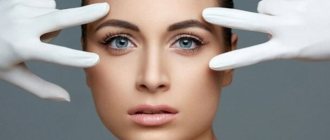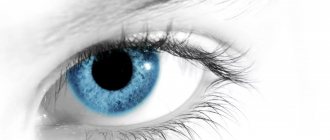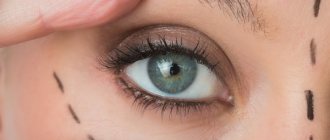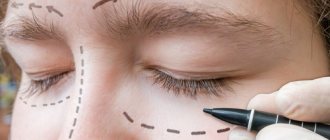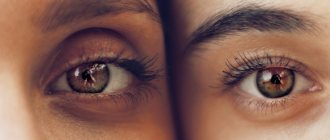Rehabilitation after blepharoplasty is usually quick and easy. It is necessary to follow all the recommendations of the plastic surgeon, and then after 2-3 weeks. you can return to your normal lifestyle.
Rehabilitation calendar after surgery by day
Swelling and bruising after blepharoplasty
Scars (scars) after blepharoplasty of the upper and lower eyelids
Limitations after blepharoplasty
Care after blepharoplasty of the upper and lower eyelids
How to get flawlessly youthful eyes for 10 years or more
You are probably considering blepharoplasty. Choose a surgeon and clinic.
You've probably already read that eye rejuvenation usually involves removing excess skin in the upper and lower eyelids, as well as fatty hernias that give the effect of bags under the eyes.
You have already been promised that a youthful look will delight you for 7-10 years...
Unfortunately, this is false information.
Firstly , in a smoking and nervous metropolis, the result of classical eyelid surgery lasts no more than 5.
Secondly , few people know that the technique of performing classical blepharoplasty was finally formed by 1950 and has undergone virtually no changes since then!
The trust of celebrity patients is one of the best proofs of the “couture” level of skill
Let’s not hide that Platinental surgeons trust their eyes to celebrities and politicians.
We are somehow accustomed to the fact that all stars undergo plastic surgery. But we rarely think that they are not only the most demanding patients. They are also the busiest. Their filming and touring schedule is planned 3-5 years in advance .
Due to lack of time and the nature of the profession, such patients always make 2 strict demands:
- the operation should take place without complications and have the shortest possible recovery period,
- the operation must provide a long-term result and be done as rarely as possible, because forced downtime can easily ruin a career.
And the stars of politics and business present one more thing.
They are not eager to make public the fact of the anti-aging procedures performed. Therefore, the operations that we perform at Platinental provide the most natural result without the effect of an operated face. Everything looks as if the person began to lead a healthy lifestyle and gets enough sleep regularly .
We are pleased to offer all these technologies to you.
Iskornev Andrey, plastic surgeon.
Eyes are the main factor of attractiveness. They determine how sociable you are, what mood you are in, what mood you are in, whether you are flirtatious or strict, analytical or, conversely, prone to adventurism.
The harmony of the eyes, like all facial features, has its own rules, but the degree of “deviation” from the conventional norm can be much greater than with the shape of the lips, nose or chin.
Despite this, there are strict rules:
— The contour of the lower eyelid should touch the lower border of the iris, otherwise the eyes look round, “fishy”, this is how the eyelid of an elderly person looks. That is why lower eyelid blepharoplasty is a special science, and only a few surgeons are concerned about the stability of the eyelid shape after such an operation.
Regular and fisheye
— The outer corner of the eye should be 2-3mm higher than the inner one. This creates the effect of an almond-shaped eyelid, which on a woman’s face emphasizes the artistry and sexuality of nature.
Regular and almond-shaped eyes
- There should be a small roll of muscle under the lower eyelid (pretarsal roll of the lower eyelid). This should definitely be taken into account when planning lower eyelid blepharoplasty. The surgeon must be able to model this roll of muscle to highlight the youthful shape of the eyelid and the natural result of rejuvenation.”
The pretarsal ridge of the lower eyelid on Kate Middleton, Emma Watts and the model from the Christian Dior show certainly speaks of their youth.
How is the operation performed?
At the beginning of a classic lower eyelid blepharoplasty, markings of dotted lines are applied to the patient's face. This way the locations of future cuts are marked. This is done in a sitting position, so as not to result in distorted facial features.
The plastic surgery itself is performed as follows:
- The patient is given an antibiotic drip.
- The skin is treated with an antiseptic, and the eyeballs are covered with protective lenses.
- In accordance with the doctor’s recommendations and the client’s wishes, general or local anesthesia is administered.
- The eyelid is secured with a medical clip and careful dissections are made on its inner and outer sides.
- When getting rid of the bags, lumps of fat are removed from the wound with thin tweezers, then the surgeon excises excess tissue.
- If the incision is made on the outside of the eyelid, then the wound is sutured using an intradermal suture. If manipulations were carried out on the mucous membrane, then self-absorbable threads are used.
- Depending on the type of operation and the practice of a particular clinic, the final touch may be the application of ice, a sterile bandage, or treatment with an erbium laser.
Typically surgery takes no more than 1 hour. And observation of an operated patient in a hospital lasts from 1 to 5 hours. Once the client is fully awake and can move freely without assistance, he can go home.
Fadin Alexander Sergeevich plastic surgeon, Candidate of Medical Sciences
Seamless blepharoplasty of the upper eyelids
Typically, to perform a classic upper eyelid blepharoplasty, the surgeon makes an incision in the natural crease of the upper eyelid and carefully removes excess skin.
The art of the surgeon in this case:
- remove as much as needed. No more and no less
- make the seam as invisible as possible and hide it exactly in a natural fold.
And only a few know that in 3 out of 4 cases, an incision on the eyelid can be omitted . Especially in young patients.
Injection removal of bags under the eyes with Eyebag Solution.
Often the cause of excess skin on the upper eyelids is drooping eyebrows. Classic blepharoplasty in this case can greatly aggravate the ptosis and sharply outline the contours of the eye sockets.
Therefore, at Platinental we offer endoscopic brow lift as an alternative to blepharoplasty. It simultaneously allows you to 1) “open your eyes”, 2) remove the overhang of the skin fold of the upper eyelid and 3) model the shape of the eyebrows.
To obtain an even more pronounced and long-lasting result, eyebrow lifting and correction is performed using absorbable implants - endotins.
This three-in-one approach allows you to avoid 100% stitches on the eyes and provides a much more pronounced and long-lasting result.
The effect of the procedure is impressive. See for yourself:
What to do if after blepharoplasty your eyes are different sizes?
Many patients are in a hurry to evaluate changes in their appearance almost immediately after plastic surgery, without taking into account the rate of resorption of edema, hematomas and the individual characteristics of healing of injured tissue. Meanwhile, such intermediate results can cause serious stress for an impressionable person.
Eyes of different sizes after blepharoplasty are a frequent cause for concern during the rehabilitation period. Typically, this condition is caused by changes in the shape or relative position of the eyelids, and this can be either an absolute norm or a complication. Is it worth sounding the alarm at the sight of any irregularities and preparing for a repeat operation? We read the material TecRussia.ru and act as necessary:
↑ Reasons for the development of eyelid asymmetry
The situation when during the first weeks and even months after blepharoplasty one eye is wider and the other is narrower is quite common. Behind the external manifestation of the problem there may be a number of reversible and irreversible changes in tissues:
- The main and most common cause of differences in the size and/or shape of the palpebral fissures is postoperative swelling. In the case of eyelid surgery, they are quite durable and can dissolve for up to six months, and sometimes even longer. Uneven accumulation of fluid in the area of the right and left eyes almost always leads to the fact that either the eyelids are at different heights, or their shape is deformed, or the incision on one side becomes narrower than on the other. But as the swelling subsides, the eyes will also return to normal and the problem will resolve itself.
More serious factors that may require additional corrective procedures and sometimes reoperation:
- The appearance of persistent ptosis of the upper eyelids. Due to severe swelling, it is almost always present to one degree or another in the first months of rehabilitation, but normally should gradually go away. Unfortunately, sometimes this does not happen completely, and if ptosis still persists within ~6 months after the operation, it will not go away by itself.
- Uneven facial expressions, when the muscles on one side are more developed than on the other - this feature could have been present for a long time and became more noticeable after surgery, or developed already during the recovery period (for example, as a result of the ptosis described above).
- Uneven structure of the facial part of the skull, and this applies to both soft tissues and bone structures. In this case, a slight difference in the size or shape of the eyes was likely noticeable before surgery, but became much more obvious after surgery.
- The formation of rough scars that unnecessarily tighten the tissues of the eyelids or change the shape of the palpebral fissure. An interesting fact: the slight, barely noticeable difference between the height of the upper eyelid folds may be due to which hand the surgeon uses. Right-handed people make a slightly less careful cut on the left side, and vice versa - but if the scarring proceeds without complications, from the outside everything will look perfectly smooth.
- Surgeon errors during the preparation and conduct of the operation: excision of too much or insufficient amount of skin, injury to muscle fibers or tendons, careless suturing, etc.
↑ Complication or not? How long does it take for your eyes to return to normal?
The speed at which tissue repair occurs after injury varies from person to person. However, there is a practice-tested general rehabilitation scheme that you can follow and, in case of obvious deviation from it, consult with your plastic surgeon:
↑ First 10-14 days after surgery
During this period, it is better not to look at yourself in the mirror at all. Tissue swelling goes away slowly and unevenly. Hematomas are “blooming” with might and main. The seams on the eyelids can be located at different levels, once again emphasizing the differences in eye sizes. However, all these troubles are not considered a deviation from the physiological norm. There are no reasons for frustration or tears: most likely the reason is asymmetrical swelling. Factors contributing to its appearance:
- sleep lying on your side or on your back with your head turned to one side;
- anatomical features of the location of veins and lymphatic vessels, which determines different rates of outflow of excess fluid from tissues;
- uneven tissue damage, resulting in more swelling on one side;
- bending over, lifting weights;
- non-compliance with doctor's recommendations regarding drinking regime.
↑ Period from 2 weeks to 2 months after eyelid surgery
In the second or third week, swelling begins to actively resolve. This does not mean that the palpebral fissures will immediately acquire ideal symmetry. But normally, the eyelids should gradually level out. If the right eye becomes more and more similar to the left, the excess fluid leaves, and there are no large folds or ridges on the skin around it, then everything is fine, you just need to be patient and allow the tissues to fully recover.
By the end of the second month, it becomes finally clear whether the asymmetry was caused by edema or other reasons that can lead to the formation of a permanent defect. If the result at this stage of the rehabilitation period is not satisfactory, you need to contact your plastic surgeon to:
- Be examined for more serious complications (signs of ptosis, problems with facial muscles, etc.);
- If everything turns out to be in order, get recommendations regarding the care of your eyelids.
Typically, manual and physical therapy procedures are prescribed to speed up the healing process. But you shouldn’t start doing eyelid massage on your own or sign up for hardware cosmetology at a salon. Such amateur activities can, at best, not produce results, and at worst, even cause harm. It is advisable for the cosmetologist to work closely with your plastic surgeon, then the result will be more predictable.
↑ Period from 2 to 6 months after plastic surgery
It is at this time that it finally becomes clear - either the operation was successful, or the eyes will remain different: one is wider, the other is narrower. The following conditions are considered problematic:
- unequal eye shape: for example, one is almond-shaped and the other is round, or one slit is significantly narrower than the other;
- the upper or lower eyelids are located at different levels, or on one side they do not fit tightly to the eyeball, do not open or do not close completely;
- the fold above the ciliary edge of the upper eyelid is deeper or located clearly higher than on the other side;
- the eyes on one side look more swollen than the other, there are skin deformations around that are not present on the eyelids on the opposite side;
- there are visible or tactile lumps in the operated area;
- at rest, the eyelids are the same, but when smiling, a clear asymmetry is visible: on one side the size or shape of the eye changes, skin folds appear.
At the same time, any conclusions should be drawn no earlier than after 4-6 months. In order to assess the real significance of the defect, it is necessary to take a number of photographs in different lighting and from different angles, experiment with decorative cosmetics and ask questions to close people whose objectivity there is no doubt about.
- Details about the main complications after blepharoplasty
- Eyelid lift without surgery: what techniques do our experts recommend?
↑ Methods for correcting eyelid asymmetry after blepharoplasty
If you have any concerns or questions regarding the results of your surgery, you should contact your plastic surgeon, get their recommendations, and follow them strictly. If there are reasonable doubts about the qualifications of the operating doctor, you can contact another, more authoritative specialist.
Depending on the reasons for the defect and how severe it is, an appropriate correction method is selected - from decorative cosmetics to repeated surgery. The most effective are considered:
- Massage. Manual or hardware treatment of the face and eyelids allows you to restore muscle tone and accelerate the outflow of venous blood and lymph. This helps eliminate swelling, remove toxic waste products from the body, which are formed in excess in injured tissues, and provides an influx of oxygen and nutrients, which accelerates healing. It is only important not to prescribe such procedures yourself, but to agree on their type and frequency with the surgeon: a lot depends on the individual characteristics of the body and how the rehabilitation proceeds.
- Microcurrent therapy (MTT). This physiotherapy procedure is most often used when it is necessary to tone muscles and restore their activity. In the case of blepharoplasty, it will help if the difference in the size or width of the eyes is due to uneven facial expressions or unsuccessful scarring, since currents promote the resorption of fibrous tissue.
- Botox. Botulinum toxin injections allow you to even out the tone of the facial muscles that move the eyelids of the right and left eyes. This is a good alternative to surgical correction if the asymmetry is not very pronounced and is caused precisely by different muscle activity on different sides of the face.
- Repeated operation. Unfortunately, this is not such a rare thing among those who once decided on blepharoplasty. Almost always allows you to solve problems caused by rough scarring and restore the symmetrical shape of the palpebral fissures. It is much more difficult to correct defects associated with the removal of excess skin. Only experienced doctors can be trusted to perform such an operation, since the likelihood of developing new complications (non-closure or inversion of the eyelid, scars, etc.) increases. And the repeated intervention itself is technically always much more difficult than the first.
However, before you think about correction and, moreover, go under the scalpel, you need to determine for yourself whether the eye is actually “somehow different” and the asymmetry is really noticeable to others, or whether the problem is more psychological, associated with inflated expectations and an overly emotional assessment of the result.
Experts' opinions:
Bytdaev Zaur Makhrovich Plastic surgeon, Candidate of Medical Sciences
In my practice, such a situation has not arisen after the rehabilitation period, but immediately after surgery it can arise due to varying degrees of swelling. To get rid of this condition as soon as possible, there is a set of measures that can effectively resolve the issue, including physical therapy. True, it is necessary to take into account that there is congenital asymmetry, which is really noticeable, but in some cases it can also be corrected.
During the first month after surgery, the difference in eye size can be considered normal. For everything to go well, you must strictly follow all recommendations and do not skip secondary examinations, because... the surgeon keeps the rehabilitation process under control. If at the end of the recovery period there is no positive dynamics, then this is a complication. The first thing the patient should do in this case is to contact his doctor to determine the causes and find a solution. It can be different: revision blepharoplasty, canthoplasty or other types of surgical intervention.
Aleksanyan Tigran Albertovich Plastic surgeon, Candidate of Medical Sciences
Eyes of different sizes occur due to inadequate surgical intervention or very asymmetrical facial variations. I believe that first of all you need to choose the right surgeon who has been performing these operations for many years and knows how to do it in order to avoid such a result. Otherwise, the intervention will have to be repeated, which greatly complicates the correction of the consequences.
Levin Sergey Lvovich Plastic surgeon, Doctor of Medical Sciences
Usually, in any person, the eyeball is more recessed on one side, and more protruding on the other and visually appears larger - this is the norm. After upper eyelid surgery, the difference sometimes becomes even more noticeable. Another significant factor is that after the operation the patient examines herself longer and more closely in front of the mirror and finds that asymmetry that she did not notice before. A less pleasant option is that if too much skin around the eyes is removed, then the difference in the depth of their seating may be amplified. And this, unfortunately, is already irreparable.
Egorova Maria Vladimirovna Leading plastic surgeon Frau Klinik
Initially, both our skull as a whole and our eyes in particular are asymmetrical. However, almost no patient notices this. After surgery, a difference may appear due to closer attention to the area, as well as the inevitable swelling. In general, the rehabilitation period takes about 6 months, during which time there may be various complaints about the area of surgery that do not require additional intervention. Different eyes are considered a complication if the asymmetry is caused by improperly performed blepharoplasty. In some cases, correction is possible, but its feasibility can only be determined individually, during a face-to-face appointment.
Lower eyelid blepharoplasty
During classic blepharoplasty, the surgeon makes an incision under the eyelash line. Its task is to eliminate excess skin and remove hernias, which create the effect of puffy eyes.
If there is no excess skin, a minimally invasive operation is performed to remove the bags - the so-called transconjunctival blepharoplasty without external incisions. An incision is made on the inside of the eye, through which the fat sac will be removed. The advantage of transconjunctival blepharoplasty is the absence of a visible scar on the face after healing.
Lower eyelid blepharoplasty at Platinental is performed differently. As a rule, simultaneously with a low-traumatic cheek lift. This technique is called Cheek lift light.
Circumferential blepharoplasty and endoscopic midface lift. Done by Andrey Iskornev.
Cheek lift techniques are varied.
- you can fill the area of the cheekbones and mid-face with your own fat (do lipofilling),
- You can lift the overhanging area of the cheekbone with the absorbable Endotine device. Endotins in plastic surgery are also called biological face lifting, since endotin is absorbed 5-6 months after injection, but the tissue continues to be stretched.
In this case, no additional incisions are required - the entire procedure is carried out through an incision in the eyelash edge.
No other eye blepharoplasty gives such a result! Just imagine. Your new face without nasolacrimal grooves, the protruding contours of the eye sockets (the transition between the lower eyelid and cheek) are smoothed, the nasolabial folds magically disappear, the cheekbones return to the top and are filled with youthful volume. Your face glows with youth!
Dry eyes after eyelid surgery
Table of contents
What is blepharoplasty?
Why is eyelid surgery necessary? Why does dry eye syndrome (DES) develop after eyelid surgery? How does dry eye syndrome manifest after surgery? How to treat dry eye syndrome? Preparing for surgery Caring for yourself after surgery What symptoms should you see a doctor for? Gilan solution to eliminate dry eyes What is blepharoplasty?
Blepharoplasty is an operation to eliminate congenital or acquired eyelid defects. It allows you to get rid of edema, fatty hernias, drooping eyelids that appear due to age-related changes or diseases of the cardiovascular system and kidneys.
Why is eyelid surgery necessary?
In most cases, blepharoplasty is performed for cosmetic purposes, but sometimes it is necessary to restore full peripheral vision.
Upper eyelid blepharoplasty is aimed at removing excess fat, skin and muscle. It is performed through an incision in the upper eyelid. Due to the natural folding of the skin in this area, the incision site is almost invisible after healing.
Blepharoplasty of the lower eyelid can be performed using both surgical and non-surgical methods. Surgery is used to remove fatty hernias. They are removed through small incisions on the outside of the lower eyelids. Scars may remain at the site of surgical wounds.
For patients without significant sagging skin, transconjunctival blepharoplasty is indicated, which is considered more gentle, since the incision is made on the inside of the eyelids and heals almost without a trace.
Why does dry eye syndrome (DES) develop after eyelid surgery?
Unpleasant sensations and dry eyes are a proven side effect of blepharoplasty. It is experienced by about 50% of patients undergoing surgery. In approximately half of them, dry eye syndrome develops immediately or some time after eyelid correction, and 26% of patients experience swelling of the conjunctiva.
Consequences such as dry eyes occur due to disruption of the integrity of the optic nerves. As a result, the mechanism for producing tear fluid malfunctions, the cornea does not wet itself in time and becomes covered with microcracks. During the postoperative rehabilitation period, the risk of infectious inflammation of the cornea increases sharply.
How does dry eye syndrome manifest after surgery?
The clinical picture of dry eye disease varies depending on the stage of the disease.
- At the initial stage, blepharoconjunctivitis develops, which is accompanied by pain and the sensation of a foreign body in the eyes, redness of the edges of the eyelids, and the appearance of mucous discharge.
- At the next stage, epithelial dystrophy of the cornea is observed. Dryness of the eyes intensifies, photophobia appears, and threads with a freely hanging end are formed on the surface of the cornea.
- At the third stage, filamentous keratitis develops. This condition is characterized by the formation of a mesh of threads filled with mucus on the eyeball. The patient's vision deteriorates sharply, pain and pain in the eyes intensify.
- In the last stage, corneal xerosis occurs. Due to insufficient tear fluid, the nutrition of the cornea and conjunctiva is disrupted. Blood vessels grow on the surface of the cornea, which leads to vision loss.
How to treat dry eye syndrome?
The treatment program in most cases is based on the use of tear substitutes. These drugs have a stabilizing effect and moisturize the surface of the eyes. Depending on the severity of symptoms, the viscosity of the artificial tear preparation is selected. Additionally, anti-inflammatory and antibacterial drugs are prescribed to reduce postoperative inflammation.
Preparing for surgery
Before blepharoplasty, a number of laboratory tests must be done. It is advisable to get tested for dry eye syndrome, since if the disease is present, the likelihood of severe complications increases.
Self-care after surgery
Blepharoplasty, like any other operation, leaves the body defenseless against infections for a certain period. In the first few days, you must maintain careful hygiene: do not use cosmetics, do not wash your face with running water, and do not touch your eyes with your hands.
The recovery period takes about 14 days. To prevent dry eye syndrome and other complications, a tear substitute prescribed by an ophthalmologist is used. To reduce swelling, topical medications may be prescribed.
During the postoperative period, it is extremely important to follow all the doctor’s recommendations and not self-medicate if complications arise.
What symptoms should you see a doctor for?
Blepharoplasty is a technically simple operation, so the occurrence of complications is most often associated with the individual characteristics of the body or failure to comply with rehabilitation requirements.
Swelling of the eyelids and hematomas usually disappear within 1-2 weeks. If this does not happen, or after the swelling has subsided, increased lacrimation, redness of the suture, increased body temperature, and increased pain around the incision site are observed, immediately consult a doctor.
Due to severe swelling and infectious inflammation, sutures may come apart.
Gilan solution to eliminate dry eyes
Tear substitute "Gilan" has a moisturizing effect for dry eye syndrome after blepharoplasty. An ophthalmic solution based on hyaluronic acid prevents the development of complications, alleviates painful conditions, and promotes the rapid elimination of edema.
Laser blepharoplasty: young eyes should look wrinkle-free!
Contrary to popular myths, it is impossible to eliminate crow's feet using classic blepharoplasty.
For radical eye rejuvenation, we at Platinental combine surgery with light fractional laser eyelid peeling. Carbon dioxide laser allows you to make the skin more elastic after surgery, erase the relief of fine wrinkles and improve its color, especially for those who suffer from dark circles under the eyes.
Resurfacing is performed in the clinic simultaneously with the operation under TIVA anesthesia, so pain is excluded.
Photos "before and after"
Circular blepharoplasty. One of the indicators of successful blepharoplasty is the stability of the lower eyelid. Changing the curvature of the line even by 1 mm gives the effect of “operated” eyelids. The result “before” and 9 days “after” the operation. Subsequently, the seam will almost completely turn white and disappear. Surgeon: Iskornev Andrey.
The photo on the left shows a patient with rounded eyelids after previously performed blepharoplasty. The photo on the right shows the corrected shape due to canthoplasty and lipofilling of the infraorbital areas. Performed by surgeon: Andrey Iskornev.
SMAS lift, upper and lower blepharoplasty, forehead lift, Hollywood neck lift, CO2 laser resurfacing. Surgeon: Iskornev A.A.
Marina Glushenkova underwent upper and lower transconjunctival blepharoplasty. The result is relief from drooping upper eyelids and bags under the eyes. Surgeon: Iskornev Andrey.
Photo from the patient’s personal archive. Completed by: Andrey Iskornev.
Elena Savitskaya “before” and 6 months “after” blepharoplasty. Surgeon: Iskornev A.A.
Review by Elena Savitskaya
SMAS face and neck lift, blepharoplasty of the upper and lower eyelids. Surgeon: Iskornev Andrey.
Done by Andrey Iskornev.
Done by Melnikov D.V.
Blepharoplasty of the lower eyelids, Cheek lift (cheek lifting) using the Endotine Midface ST fixator. Done by Andrey Iskornev.
Blepharoplasty of the upper and lower eyelids, cheek lift light. Surgeon: Iskornev Andrey.
Bags or dark circles under the eyes occur not only due to pathology. Sometimes, after a party or drinking a lot of liquid at night, bags can appear in healthy people. These are fatty hernias of the lower eyelids.
Transconjunctival blepharoplasty can help get rid of dark circles or bags under the eyes. Excess fat hernias are removed without visible incisions. As a result, the bags will disappear, and dark circles will not appear even after the New Year holidays.
Completed by: Vasiliev Maxim.
The administrator is the face of the clinic! Blepharoplasty of the upper and lower eyelids, SMAS lifting of the lower third of the face. Plastic surgeon: Iskornev A.A.
Scars (scars) after blepharoplasty of the upper and lower eyelids
Many patients have a question: do scars remain after surgery? Of course they remain. But you shouldn’t be scared, since they are practically invisible and look like a thin strip, and with transconjunctival blepharoplasty they are not there at all.
The next reasonable question is how to remove scars?
It is impossible to completely remove scars; you can make them almost invisible. And for this, after the operation it is necessary to undergo special treatment. And then patient reviews on the quality of scars after blepharoplasty will be 99.9% positive.
photo scars / scars after upper/lower blepharoplasty
And one more question that concerns patients: what should they use to smear the scars after surgery so that they are invisible? Let’s look at these remedies and scar treatment in more detail.
Scar treatment
There are a huge number of different scar care products, including various drugs:
Gel after blepharoplasty
contractubex
It is a combined preparation in the form of a gel, the effect of which is determined by the properties of its constituent components: Allantoin, Heparin sodium, Onion. It has fibrinolytic, anti-inflammatory (due to the extract of Serae bulbs), antithrombotic (due to heparin), and keratolytic effects (due to allantoin). Causes stimulation of cellular regeneration without hyperplasia. Prevents the formation of keloid scars by inhibiting fibroblasts.
dermatix
The drug is in the form of a silicone gel for external use, transparent, colorless and odorless. Consists of a mixture of polymeric organosilicon compounds (polysiloxanes). Helps maintain uniform moisture in the eyelid skin, has a corrective effect on scars after upper and lower blepharoplasty, smoothing and softening them, relieves pain, itching and discomfort, and also reduces skin redness.
Silicone patch
Silicone patches are also a large group of scar care products. But when applied to eyelids, they are not entirely comfortable. The most famous companies on the Russian market are Dermatix and Mepiform.
Enzyme preparations
A group of drugs intended for the treatment of hypertrophic and keloid scars.
longidase
Longidase is a drug whose main active ingredient is the enzyme hyaluronidase. This enzyme
- increases the permeability of connective tissue;
- stops the process of gross scarring by reducing the formation of its own collagen in the cells of the dermis;
- increases the level of elasticity of the skin of the eyelids.
The drug is available in the form of a dry substance in ampoules. Before use, it is dissolved in 2 ml of liquid (saline or 0.25% lidocaine solution) and injected directly into the scar with a needle.
lidase
An enzyme preparation whose main active ingredient is hyaluronidase.
It is known that hypertrophic and keloid scars are formed due to excessive synthesis of hyaluronic acid. With its participation, at an early stage of the wound process, the production of fibroblasts is stimulated, which produce new skin cells in huge quantities.
When lidase is introduced, excess hyaluronic acid is eliminated, since lidase acts on this acid and decomposes it into glucosamine and glucuronic acid. As a result, microcirculation and cell permeability improve in the scar area.
Available in ampoules as a lyophilisate. Before use, like longidase, it is dissolved in saline and injected under the problematic scar. If injections of the drug are painful, it is better to dissolve it in a lidocaine solution.
imoferase
Eye cream after blepharoplasty, like Lidaza, contains the active ingredient Hyaluronidase, which suppresses the growth of connective tissue and reduces swelling.
With a course of treatment, raised scars decrease in volume, pigmentation decreases, and the elasticity of the eyelid skin increases.
A good property of Imoferase Cream is its ability to act on old scars and scars, reducing their density.
Hormonal ointments and suspensions
hydrocortisone
Hydrocortisone ointment has an anti-inflammatory effect and inhibits the growth of connective tissue. It is used after blepharoplasty and eyelid pathology. Hydrocortisone is a glucocorticosteroid, the use of which can cause many side effects. Therefore, the drug can be used only when prescribed by a doctor.
diprospan
The main active substance is the glucocorticosteroid betamethasone, the effect of which is that it stops the pathological growth of scar tissue, causing the scar to become smaller and flatter. The main indication for use is keloid scars. Uncontrolled use can cause tissue atrophy.
After blepharoplasty it is practically not used
Limitations after blepharoplasty
After blepharoplasty, it is necessary to follow the recommendations for a restrictive regime. Below are the dos and don'ts after surgery:
sports and physical activity
During consultations, I always tell you in detail when you can start playing sports after blepharoplasty. In the first days, it is better to avoid any exercise, as this can lead to an increase in blood pressure and provoke bleeding. A home regimen for 2-3 days is recommended. As a rule, after a month you can fully start playing sports and fitness.
solarium
You can visit the solarium 1 month after blepharoplasty, but be sure to cover the eyelid area, otherwise persistent hyperpigmentation may appear.
alcohol and smoking
Many patients are concerned about when they can drink alcohol and smoke cigarettes after blepharoplasty. It’s better not to drink or smoke at all and say “no” to bad habits! But if you really want to, then no earlier than 2 weeks, as they negatively affect healing.
Tan
You can sunbathe in the sun after 1 month, but you need to use sunscreen, otherwise you can get persistent hyperpigmentation
makeup
Many people are interested in when they can paint their eyes after blepharoplasty. Makeup (cosmetics) can be applied within 5-7 days after surgery. It is necessary to pay attention to any redness, and if it appears, you need to remove makeup so as not to provoke an allergic reaction.
Job
You can return to work 3-5 days after blepharoplasty. But if possible, it is optimal to stay at home for 2 weeks.
eyelashes and tattoo
You can get eyelash extensions 1 month after eyelid surgery. Tattooing can be done 1 month after surgery.
lenses and vision
Lenses after upper blepharoplasty can be put on immediately, and after transconjunctival blepharoplasty - after 10-14 days. For a period of up to 2 weeks, it is necessary to exclude working on the computer and phone, reading books, watching TV and giving your eyes rest.
Botox and Dysport
Botox or Dysport can be injected 1 month after blepharoplasty.
sex
There are no strict restrictions on sex
Postoperative period
- Sutures are removed on days 2–6 after surgery.
- Day 7 – You can go to work.
- Bruising and swelling after blepharoplasty can last up to 10 days.
- During the first week, it is recommended to limit sports and dancing, sexual contacts, and refrain from cleaning, reading and watching television.
- Starting from day 8, you can use hypoallergenic decorative cosmetics.
- 14 days – it is forbidden to sunbathe in the sun or in a solarium.
- 21 days – it is not recommended to use contact lenses.
- 30 days - avoid hot showers, saunas, baths and swimming pools.
- For 3 months after surgery, you need to use sunglasses to protect from ultraviolet radiation.
Caring for seams
I think you have a general idea about caring for seams. In most cases, the algorithm of actions is the same and simple.
As with any other plastic procedure, after blepharoplasty the doctor applies a sterile dressing to the stitches.
At the same time, experts recommend applying cold compresses to the affected areas. This will reduce swelling.
You will be allowed to wash your face only the next day. And cold water. And so that the bandage and stitches remain dry.
Next, if everything is fine with the stitches, the doctor will either remove the stitches, or (if the threads are self-absorbing) will tell you in detail what will happen to them.
In addition, the specialist will explain how to treat seams at home.
To speed up the healing process, special ointments and creams may be prescribed.
It is important here not to self-medicate. Use only medications approved by your surgeon.
Seams
Scars after blepharoplasty are no thicker than a “cat scratch” and are located strictly in natural folds.
Complete absence of scars after upper blepharoplasty 3 weeks after surgery. Surgeon - Vasiliev Maxim.
For additional resorption, fractional laser resurfacing of the skin of the upper and lower eyelids is performed 1 month after surgery. As a result, the seam will not be visible even to the most experienced “best friends” without makeup.
Care after blepharoplasty of the upper and lower eyelids
After blepharoplasty, patients are prescribed various medications (for example, antibiotics) and undergo physiotherapeutic treatment (lymphatic drainage massage, microcurrents, electrophoresis and ultrasound) for quick recovery.
The speed of rehabilitation after blepharoplasty depends on proper care of the surgical area. It includes a set of measures affecting the skin of the eyelids, suture lines and eyes. It’s worth looking at this in more detail:
seam care
Immediately after the operation, a special patch is glued to the suture area - strips, which act as a protective bandage. They are removed after 5-7 days. For a week, it is necessary to treat the suture line with antiseptics, for example, an alcohol solution of chlorhexedine and apply cool lotions with furatsilin 5-6 times a day for 15 minutes, 3-4 days, then less often, 3-4 times a day (you can use cool bags of brewed tea, medicinal herbs - chamomile, St. John's wort).
eye care
The eyes are not injured in any way during the operation, so they do not require special care. However, wearing lenses is avoided to avoid causing irritation. Very often after blepharoplasty, symptoms in the eye area such as irritation, itching, dryness and redness may be observed.
If the above symptoms occur, you must use special eye drops. They will help you quickly and painlessly get rid of unpleasant manifestations. The most common drugs include:
- Artificial tear;
- Tobrex;;
- Systane.
upper and lower eyelid care
pursues the following goals:
- protects seams from contamination
- accelerates the resolution of edema
- stimulates the wound process and rapid healing
In addition to the recommendations of the plastic surgeon, in the postoperative period, you can perform a special set of exercises for the eyes, which is necessary to improve blood supply to the surgical area, to accelerate the resolution of swelling and reduce the inflammatory process.
Self-massage also helps in restoring the periorbital area. The essence of the massage is that point circular pressure is applied with the fingers in the eyelid area.
